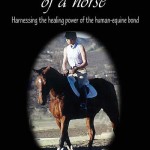
Love, understanding, trust. These are the words we hear to describe what people look for in relationships, and while they may guide our actions with one another, do they apply to our relationships with horses?
The question we are really asking here, is: do horses crave the same things that people do? In essence, do the needs of horses align with those of people? While the answer to this question may be obvious, it is worth asking nonetheless. Clearly, horses’ needs are very different from those of people. Not bestowed with the comforts of an insulated world, the equine species lives at the center of what we consider our most primitive need — safety. While we have easily surpassed the hyper-vigilant state that is horses’ everyday experience, for them, life is still a minefield of scary objects. And yet we have even brought them into our world — away from the only safety they know — to face what, to us, is not scary, but to them, often overwhelming. To be sure, we ask them to walk down our streets, live in our building, and even wear the clothes we make for them.
So in hoisting them fully out of their familiarity, how often do we consider what they really want? The answer, unfortunately, is not much. Watching any person, new to horses, approach a horse for the first time is a lesson in just how frequently our understanding horses’ needs become enmeshed with our own. While the intentions are good, for sure, people give them what they would want. Applying affection first, people fail to consider that horses, who are driven by the unending need for safety, do not find safety in affection.
Observing herd behavior — particularly that of a mare and foal — under distress, would not reveal a display of affection-oriented actions. Instead, the mare would very deliberately move the foal out of harm’s way — away from the scary object — and placing her body between her foal and what is threatening, she would offer protection. In this way, protection is an act of leadership, in the form of controlling the space. For in the example above, if the foal were to attempt to move out of his mother’s protective cushion, she would not allow it. And why? Because allowing the foal to move when his movement may induce harm would defy protection.
Yet, this is not to say that horses do not include affection in their repertoire of behavior. They do, however, they determine safety first. For example, when horses are introduced to each other for the first time, the first thing they do is determine who leads, and who follows. To do this, they may squeal, kick, or even bite one another. However, once this hierarchy is clear, it remains, and affection commences.
While this may be opposite that of typical human introductions — being affection before roles, rules, and expectations — it is probably not that far removed from what people actually want. After all, how often do we exchange pleasantries one minute only to find out much later, what the other really wants?